Listed 72 sub titles with search on: Sights for wider area of: "KYKLADES Island complex GREECE" .
POSSIDONIA (Village) SYROS
Possidonia was the place chosen by the island's wealthy families for their country retreat, at the turn of the last century. A number of villas were built in the grand neoclassical style of the time. Today, some are open to the public.

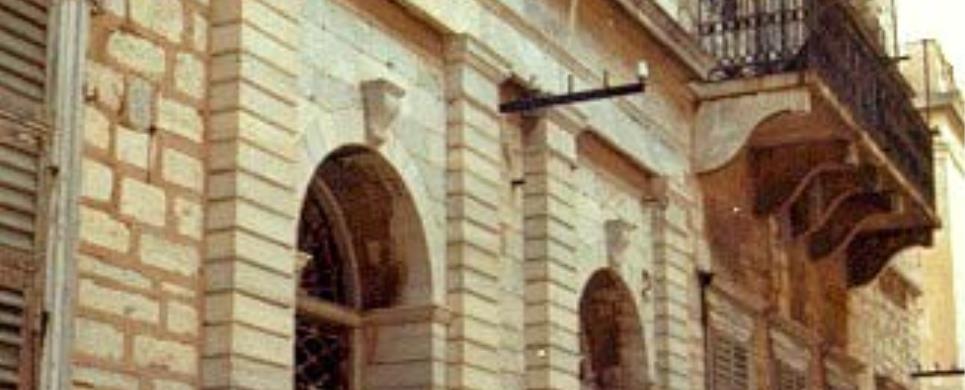
SYROS (Town) KYKLADES
Tel: +30 22810 79133
Massive building of monumental style with simple
architectural lines and interesting construction. It has marble-built parts
with furrow joints while marble stripes separate the stories and a cοnvex and
concave moulding sets off the edifice's base. The final cornice is of marble and
there is also a built parapet around the chamber. The building could well be described
as an apartment building since it had different entrances. Morphologically
and historically, the building is significant. As it can also be seen at the signposts,
there lived Ch.A.Kriaras, resided King Otto and stayed E. Venizelos while an infant.
From 1935 to 1963, it served as a Girls' Highschool.
By a ministerial decree of 1987, the building was identified as a
work of art encircled by a protection zone extending to the property's boundaries.
Today, part of the building is inhabited while the rest is empty.


The first Secondary School of Hermoupolis is situated behind the Town Hall. Founded in 1833, it was the first of its kind, not only in Hermoupolis, but in the whole of Greece. Together with the Secondary School of Nauplion, these were the first buildings constructed especially for this purpose. It is a two-storeyed building, ornately decorated along the central part of the first floor. It was designed by the Bavarian architect Herlaher and it was inaugurated on the 13th of November, 1834. According to an inscription at the entrance to the building, its first headmaster was Neofitos Vamvas. It has comfortable, high-ceilinged rooms. In the central hall on the first floor, we see a large frescoe of the Parthenon. Not only children from Syros studied there, but also from Chios, Psara and Crete. The school counts among its pupils such eminent figures as Eleftherios Venizelos, Dimitrios Vikelas, Andreas Sigoros, Klon, Kiparissos Stefanos and others.
This text is cited Apr 2003 from the University of Patras' XENIOS DIAS website URL below.
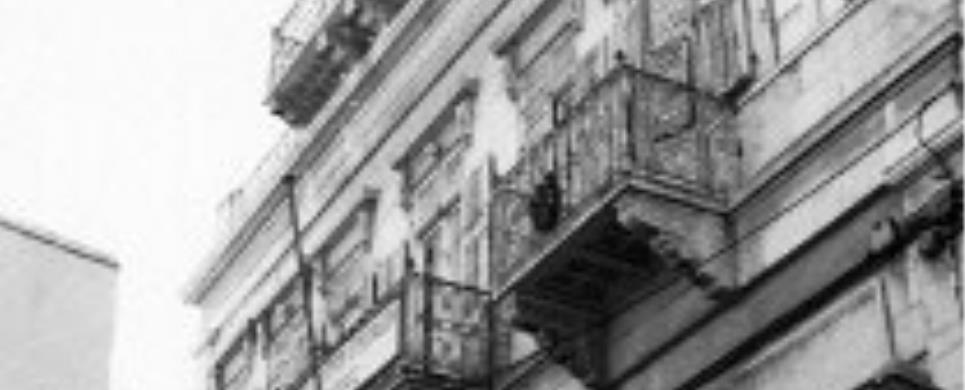
Tel: +30 210 3253059, 3243289
Fax: +30 210 3232547
The building is a mansion of heavily decorated architecture in the outside and
interesting adornments inside. It is marble-built with masonry ashlar and a gable
pediment on the third floor's shaft. Among its characteristic elements are the
well-worked arched openings of the ground-floor shops and the decorations of exceptional
technique on the stories (balcony windowsills, window cornices with legs dentils.
The mansion was built by the architect, T. Vlysidis from the island of Syros.
After its recent repair, the wall-paintings were destroyed (mainly
those in the stairwell).
By a ministerial decree of 1987, the building was identified as a
work of art encircled by a protection zone extending to the property's boundaries.


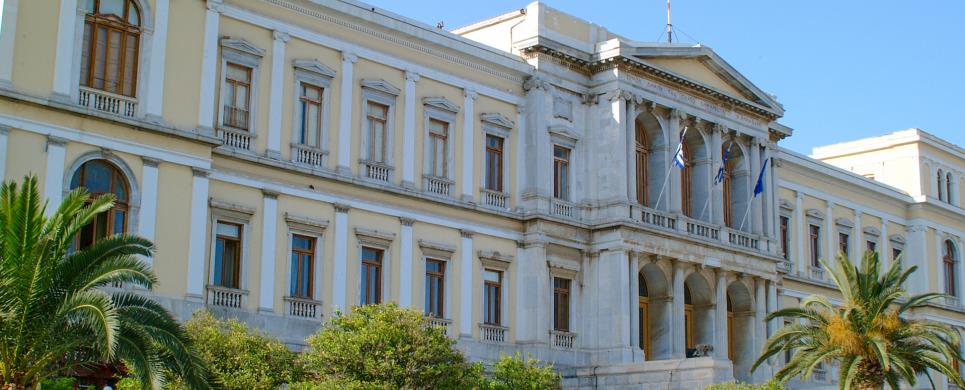
Tel: +3022813 61000
Fax: +3022810 88232
TINOS (Small town) KYKLADES
Chora boasts a number of neoclassical houses, built by the bourgeoisie of the 19th century.


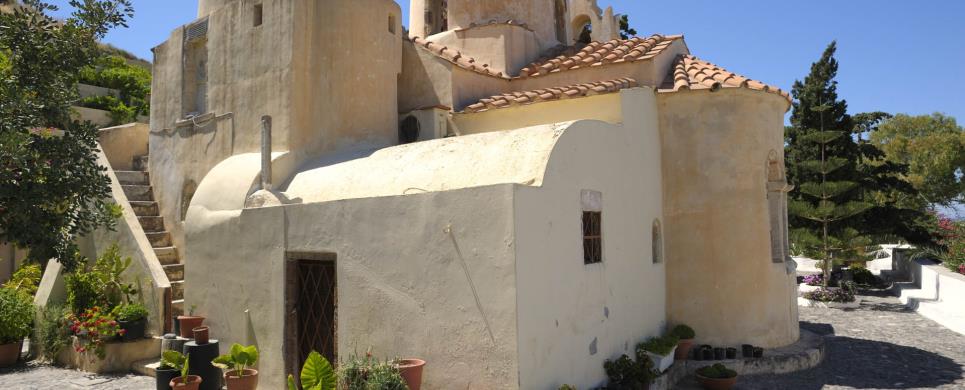
EPISKOPI GONIAS (Village) THIRA
Tel: +30 22860 31451
AMORGOS (Village) AMORGOS
Venetian Castle - Hora the capital of Amorgos, is a small town hidden behind the mountains, At its south-eastern edge the hill is crowded with the old wind mills. The "Kastro" -castle rock rises out of the village, as a guardian of Hora, over the years since the Venetian occupancy. The historic rock with a height of 210 feet wedges for more than fifteen centuries the church of Kera Leousa (our Lady of mercy), the oldest one in Chora, A narrow stone staircase in the rock, leads to the small St. George Church from which the entrance to the fortress with its preserved low gate is. Around the rock's base,
spread the old stone buildings and forty churches of very interesting architecture.

ANDROS (Small town) KYKLADES
It was built in 1207 and all the building work lasted for 26 years. You can see it just at the end of the peninsula of Hora - Andros town opposite the square of "the Unknown sailor".The little island on which the imposing Venetian castle is built , is connected by Hora with a little stony arch.
The castle used to be a fort to protect Hora in the past. However , its greater part was destroyed during the second world war.
EXOMVOURGO (Municipality) TINOS
The highest mountain of Tinos (640m) is the location the Venetians chose for their castle in 1207. They surrounded this stronghold by two enormous buttress-walls. It is the most strategic spot on the island. In 1901, a huge marble cross was erected on its summit. The cross was destroyed in 1915, and restored in 1931.
HERAKLIA (Island) KYKLADES
These are the remains of a castle of Hellenistic Period (323 b.c-316 b.c.). Also
found are the ruins of the temple of Zeus and that of the Goddess of Luck. It
was a settlement until 1930.


KOCHYLOS (Village) ANDROS
Pano Kastro (Upper Castle) or Faneromeni Castle or The Old Lady's Castle was the strongest and largest city in Andros island during the middle-ages. It was built by Venetians on top a spectacular plateau north of Ormos, at a height of 600m. It could protect around 1000 (or more) people and it was considered to be impregnable, thanks to the high rocks and the strong wall surrounding it. Its history is unknown and this is the probable reason for the myths associated with it. According to the most known, the Ottomans, who could not conquer it, send there an old lady with her pregnant daughter to ask for help. Instead, the same night the old lady opened the gate and the Ottomans who finally went inside, slaughtered all the people. Later, the old lady, having regretted for what she did, climbed on a high peak and committed suicide, jumping towards the sea. So, her memory remained imprinted in two sights of the area: "the Old Lady's Castle" and "the Old Lady's Jump" (Grias Pidima), a nice beach nearby. Nowadays it is accessible through a path starting from Kochylou village and somebody can see ruins of houses, churches, cisterns and Faneromeni church. Above all, there is the magnificent view of the Aegean Sea and an impressive landscape.
This text is cited Feb 2003 from the Municipality of Korthi URL below, which contains image.



LOUTRA (Settlement) KYTHNOS
Oria Castle, for a short time a pirate hideout, was first occupied
in the tenth century AD and served as the island's capital during the Byzantine
period and Latin rule.
This extract is cited May 2003 from Kythnos
Association of Tourism Professionals tourist pamphlet.

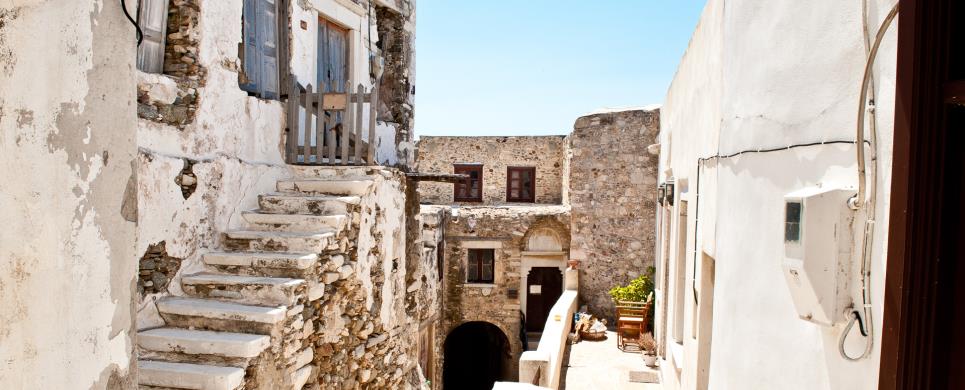
NAXOS (Town) KYKLADES
Tel: +30 22850 22725, 24150
Fax: +30 22850 22725
Border tower
protecting the fortress (Castro) of Sanoudos
in Chora, Naxos. The wall surrounding the fortress is pentagonal and has three gates. The Glezos tower (Krispi)
stands near the northwestern gate and extends in part along the western and northern
side of the fortress (Castro). It has four levels (floors) and it is the only
tower in Naxos that has also a round tower attached to it.
In 1207 Frankish rule was established in the Aegean. The Venetian
Markos II Sanoudos built the fortress of Chora in Naxos with circuit towers, one of which, the Glezos tower
(Crispi) is still preserved. Over the main entrance to the tower is the
coat of arms of the Crispi family.
The tower has been ceded by its owner, Mr. Petros Glezos to the Archaeological
Service, to become home of the first Byzantine Museum in the Cyclades.
PALIOKASTRO (Castle) IOS
At the eastern side of the island, above the beach of St. Theodotos, lies a very interesting archaeological site: it is the surrounding wall, 2,5 m high, of a fort. The church of the Virgin Maria Paleokastritissa is built on top of this fortress.

SERIFOS (Village) SERIFOS
This defensive settlement is built on a hill by the Seriphos port.
In the 15th century this was the see of the Venitian rulers of the island and
specifically of the Picchieli.
This defensive settlement still preserves its medieval fortification.
Although Seriphos was ruled by three Venitian families, the Giustigniani, the
Ghizi and the Picchieli, this is the only remnant of them that still exists.
This text is cited Sept 2003 from the Hellenic Ministry of Culture URL below.

FOLEGANDROS (Island) KYKLADES
From the small hamlet of Karavostasi, which is also the island's port,
one can get to the cave of Chrysospilia ('Golden Cave') in thirty minutes by caique.
It is thought to be one of the largest caves in Greece, but remains unexplored.
It is ten metres from the sea and its vault is propped up by stalagmites in strange
formations.
Aside from the impressive stalagmites and stalactites which form its
interior decor, the cave is also of interest as a significant archaeological site.
Human skeletal remains, pieces of broken pottery and countless male names have
been found here. It is believed that the cave was a place of worship for the ancient
Greeks and it is possible that the protecting gods of the island were worshipped
inside it.
This text is cited Apr 2003 from the Development Association 21th Geographical Unit URL below, which contains images.


The cave is situated on the North-Eastern cliff of the island. It
has much more lithomatic decoration. The characterist is the writing of ancient
names mainly youths "KALON". There are sparely in the first room mainly
and are frequented in the very interior. There are on the walls and on the roof
of the rooms. 400 names are identified and 30-40 of them are mentioned for the
first time.
Ancient writers are mentioned the cave but mainly travellers of the
past century, they managed despite the difficulties, to go up to the first room
where are Roman basins and they mention the existence of ancient findings.
The cave is not touristically developed. It was used as a hidding
place in the recent years.
This text is cited Sept 2003 from the Hellenic Ministry of Culture URL below, which also contains image.


HERAKLIA (Island) KYKLADES
When in Iraklia one can visit the cave of Agios Ioannis (St. John).
It is the biggest cave of the Cyclades and one of the best in Greece. Consists
of a maze of incredible stalactites, stalagmites, columns and a rare kind of "cave-milk"
and it takes two and a half hours to explore it. It is situated at a panoramic
site with full view of the sea and nearby island. From the village Panagia it
takes one hour to walk to the cave.
Legend has it that sometime at the end of the 19th century, a shepherd
had lain down under a bush to seek refuge from heavy rain. When he later reached
the village, his friends noticed that at the back of his shirt there was the face
of St. John the Prodrome. They asked the shepherd to show them were he had lain,
and when they got there they discovered the entrance of the cave and icon (painting)
of St. John the Prodrome. That's how the cave got its name, and every year on
that day, the celebration held in memory of the beheading of St. John, vespers
are held at the big hall of the cave and visitros from nearby island as well as
tourists attend.


SYNETI (Village) ANDROS
Dipotamata is a river-basin of extreme natural beauty, with a length
of about 7 kilometers, in the south-east side of the island, between Syneti, Paleokastro
and Kochylou.
Water these days is less, but even in drought times it doesn't stop. The natural
environment is unspoiled, since the traffic has stopped since the last 35 years.
As a consequence the vegetation is very thick (oleanders, mulberry-trees, fig-trees,
oak-trees, bushes, reeds, rushes, blackberries, mint, osiers, ivies). The whole
area is a shelter for a variety of animals, such as weasels, badgers, hares, snakes
and birds (partridges mainly).
The gorge is crossed by a wide slated cobbled road (the only road
connecting Korthi
with Chora till 1950).
In the intersecting point with the river, there is an arch-shaped bridge and occasionally
small fountains. There are also other narrow step-like paths connecting the other
villages of the area with the fields and the water mills. In good condition there
are also (apart from the paths, the stone-walls, the water-mills and their auxiliary
constructions) sheep-cotes, stables, lodgings, barns, threshing floors and country
churches. But the most important structures of the area are the water-mills.
The reason that in Dipotamata was built a large number of water-mills,
was the particularly favourable conditions for establishing and operating them:
plenty of running water, good access through the paths, protected environment,
small distance from villages, etc. Today can be seen (in good condition, in ruins
or in traces) 22 water-mills in all the gorge. Most of them are in very good shape.
In a few of them there are neighbouring or adjacent auxiliary buildings, such
as a room for the miller to spend the night, sheep-cote, stable or store room.
Hydraulic works of big importance and extent for the time and its technological
level were supplying and often netting the water-mills. In narrow places of the
gorge there were dams, which were forming lakes, to collect water for watering
purposes and the functioning of the water-mills. From there, canals were guiding
the water in the millpond and eventually into the hole of the machinery of the
mill. The remaining water and water coming out of the mill (having rotated its
wheel) was guided to the canal of the next water-mill.
This text is cited March 2005 from the Municipality of Korthi URL below, which contains images.
POSSIDONIA (Village) SYROS

KORTHI (Municipality) ANDROS
Like in all the other Cycladic islands, also in Andros the wind power
is used, nowadays by the use of wind generators and formerly by the use of an
extensive network of wind-mills.
In Korthi
area (and in Serifos
island) was developed a special type of wind-mill, tavlomylos, with the wheel
rotating horizontally, having a vertical axis. In the Municipality area exist
such wind-mills and of the classical type too, which were in operation till the
middle of last century, producing flower.
Contrary to the other islands, Andros has plenty of water. As a consequence,
it was natural to use water power too. So it was formed an even greater network
of water-mills, since the use of water as a driving force has, compared to wind,
the advantage of stability, durability and better control, regardless of weather
conditions.
In Korthi area you can find more than 40 wind-mills, excellent samples
of pre-industrial technology. Most of them are in Dipotamata, but there are also
in Aidonia, Vouni
and Piso Meria.
This text is cited March 2005 from the Municipality of Korthi URL below, which contains image.


These unique buildings, fine samples of folklore architecture, are
found in a big number all around Municipality area.
These structures are used as pigeon houses, barns and even houses.
Walking through the old stone-paths you will come across many pigeon
houses, some of them elaborate, others plain-built, small and big. Most of them
are well maintained and white-washed, serene points of reference on a landscape,
sometimes peacefull too and othertimes rough and abrupt.


PYRGOS (Settlement) TINOS
The cemetery of Pirgos is well known, attracting many visitors every day, both Greek and foreign, who come to see the tombs of exquisitly carved marble. It dates from the middle of the 18th century.


HERAKLIA (Island) KYKLADES
From where one can admire the view of all the islands that are around Iraklia.
From this point bird-watchers can indulge in their hobby because some rare species
of birds can be spotted from here.


ANO SYROS (Small town) SYROS
The village of Ano Syros, built on top of a hill, is a fine example
of a typical Mediterranean township.
Dating back to about 1.200 A.D., it is the first settlement on the
island. Because of the need to protect themselves against pirate attacks, the
islanders naturally chose the site for their villages with their best chances
of survival in mind. Along the centuries, people constructed their houses in such
a way (one practically on top of the other) as to create a virtual fortress to
protect them from their enemies.
Apano Chora, as Ano Syros is called by the locals, offers a splendid
view. This a very well preserved Mediterranean village, with all its traditional
architectural features still intact. It is a labyrinth of narrow, winding alleys
linked by whitewashed stairs and archways. These, along with tiny, flower-filled
courtyards, balconies and doors of carved wood, characterise its architecture.
There is a Catholic church or monastery around almost every corner of Apano Chora.
The architecture of Ano Syros has nothing in common with that of neoclassical
Hermoupolis. Despite their proximity, they are two different worlds.
This text is cited Apr 2003 from the University of Patras' XENIOS DIAS website URL below.
KINI (Settlement) SYROS
Hundreds of inscriptions of the Roman and Byzantine period are engraved on the rocks of Ormos Grammata .
These inscriptions are the thanksgivings to Serapi, Aesculapis, Ilios, Dioscuri and Agios Fokas, offered by sailors who survived storms at sea.


PANAGIA (Settlement) SERIFOS
The most important Byzantine church on the island is that of the Panagia
(Virgin), built between 950 and 1000, in the village of the same name, 4 kilometers
north of Hora. Unfortunately, little has been preserved of its once splendid frescoes.
This extract is cited May 2003 from the Municipality
of Serifos tourist pamphlet.

AMORGOS (Village) AMORGOS
Is a medieval cistern, which supplied the population with water and whose initial use corresponded with the first organized habitation of Hora in the early Byzantine era.Today's cavy form, was taken during the Venetian domination, on the 15th century.

PYRGOS (Settlement) TINOS
The central square of Pirgos, with its age-old plane tree, its imposing marble public fountain, its traditional "kafeneion" (village cafe) is one of the finest examples of traditional village squares in Greece.


SYROS (Town) KYKLADES
Miaouli Square is impressive indeed. It is paved with marble slabs and bordered by tall palmtrees. The statue of admiral Andreas Miaoulis and the marble circular bandstand of the Philharmonic Orchestra are its main features, apart from the impressive Town Hall of Hermoupolis.
The Prefecture of the Cyclades is housed in a neoclassical mansion on Tsiropina square.
KATO SAGRI (Settlement) NAXOS
MEGALO CHORIO (Village) SERIFOS
Eight kilometers west of Hora lies Megalo Horio (Big Village), built
on the site of the ancient capital of the island. Nearby one can see the ruins
of a Hellenistic tower known as Lefkos Pyrgos of Aspropyrgos (White Tower), while
at the place called Kastro tis Grias (the old woman's castle) some traces of walls
and houses are visible. The area once held the key to the island's economy; it
is here that the iron ore was mined. The metal was loaded onto boats from the
little port of Megalo Livadi, situated in a protected cove on the southwest coast,
and shipped to various destinations. Further south, on the Cyclop's Hill are the
ruins of a second Hellenistic tower, called Psaropyrgos.
This extract is cited May 2003 from the Municipality
of Serifos tourist pamphlet.
ANO SYROS (Small town) SYROS
Piatsa is the centre of Ano Syros. Here, one finds taverns, shops,
exhibition-galleries, etc. Lately, Piatsa has seen an increase in shops and places
for entertainment, particulary of the musical kind. It is the site of the bronze
bust of Markos Vamvakaris, and it still is the most lively part of the village,
thus attracting many visitors. This is the place for visitors who wish to combine
sightseeing with a sampling of the excellent local specialities while enjoying
the magic atmosphere of the island. Within its perimeters, one can find the Town
Hall of Ano Syros, the Historical Archives, the Folk Art Museum and the
Cultural Centre.
This text is cited Apr 2003 from the University of Patras' XENIOS DIAS website URL below.
SYROS (Town) KYKLADES
The Vaporia Quarter, the architectural jewel of Hermoupolis, is situated behind the church of Agios Nikolaos. A number of magnificent, restored buildings, with their wonderful frescoes, are situated here. Their proud occupants mainly belonged to the island's powerful shipowners' dynasty. This part of the town offers a breathtaking panoramic view of the Aegean Sea.
STAVROS PORT (Settlement) TINOS
The old harbour of Stavros was built in 1823. The bollards are, in fact, pillars from the ancient temple of Poseidon. The beach lends itself for a refreshing swim.


Receive our daily Newsletter with all the latest updates on the Greek Travel industry.
Subscribe now!